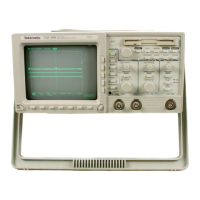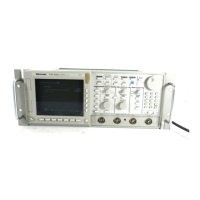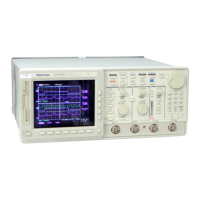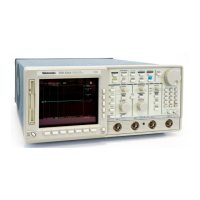Using the FFT
3–36
TDS 340A, TDS 360 & TDS 380 User Manual
Considerations for Using FFTs
There are several characteristics of FFTs that affect how they are displayed and
should be interpreted. Read the following topics to learn how to optimize the
oscilloscope setup for good display of your FFT waveforms.
A 1000-point time-domain record is input for the FFT. Figure 3–24 shows the
transformation of that time-domain data record into a frequency-domain record.
The resulting frequency-domain record is initially 1000 points that contain both
positive and negative frequencies. Since the negative values mirror the positive
values, only the positive 500 values are kept. Then, each value is repeated to
make a 1000-point frequency-domain record.
1000-point time-domain record
FFT
1000-point frequency-domain record
Negative frequencies Positive frequencies
Each point duplicated
Figure 3–24: FFT time domain record vs. FFT frequency domain record
When you turn on an FFT waveform, the oscilloscope displays the magnitude of
the FFT frequency domain record. The resolution between the discrete frequen-
cies displayed in this waveform is determined by the following equation:
Where: D F is the frequency resolution in Hz.
Sample Rate is the sample rate of the source waveform.
FFT Length is the number of independent points in the FFT.
F +
Sample Rate
FFT Length
+
Sample Rate
500 samples
The sample rate also determines the range these frequencies span; they span from
zero to one-half the sample rate of the waveform record. (The value of one-half
the sample rate is often referred to as the Nyquist frequency or point.) For
FFTs Transform Time
Records to Frequency
Records
FFT Frequency Range and
Resolution

